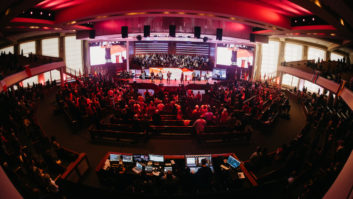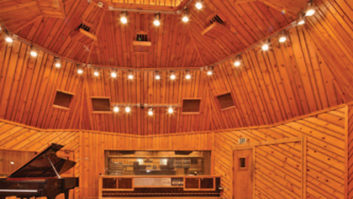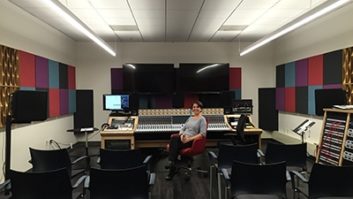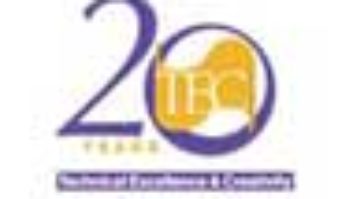A 48-channel API Vision resides in Finger Lakes’ new stereo mix room. CANANDAIGUA, NY—After experiencing incredible student body growth over the past few years, Finger Lakes Community College recently bequeathed its former cafeteria space to the Audio Sciences department. This increased the AS degree program’s Walters-Storyk Design Group-designed instructional control rooms to a total of five. Along with the physical expansion, the department was also given a generous budget to purchase two new world-class analog consoles and facility-wide matching nearfield monitors alongside new outboard gear and microphones.

“We were running out of space due to the number of students coming into the program,” explains Bob Potter, Finger Lakes Recording studio manager and technical specialist. Finger Lakes’ AS degree program consists of four semesters of audio engineering instruction, including lab and studio sessions, music theory, performance ensembles, music business, sound reinforcement/live recording and audio for film classes. “As we are a community college, our program is, quite frankly, much more affordable than others. So, with a big influx of students, we needed more space. Three studios proved not to be enough, even with 24/7 available access. Being one of the largest programs on campus, the college gave us an entire floor to renovate into practice rooms, classrooms and mainly the new studios.”
Potter attended the 2013 US AES Convention to research the best possible choice in consoles. Little did he know that he wouldn’t have to select just one. “At that point, we were so excited about the possibilities,” Potter recalls. “If were going to go ‘big-time,’ what should we do? We knew we wanted large format and analog. We debated the attributes of the API Vision and the SSL Duality, thinking that we would only get one and the other control room would be a smaller mixing suite. But after returning from AES, having had the opportunity to sit down with both parties there and look closer at our budget, we were able to get both.” As such, an API Vision now resides in the large-format stereo mix room and the other room, a surround mix room, hosts the SSL Duality. Both are 48-channel consoles.
“We wanted to give our third-and fourth-semester students a professional, real-world scenario of working in a major market studio,” explains Potter of their choices. “Too often, you don’t often leave a recording program with very much hands-on experience with a large-format console. With luck, that usually happens after college, spanning over a couple of years after getting a foot in the door at such a studio. By having the API Vision and the SSL Duality, we are giving our students a real leg up, with experience on large-console standards most often found in major studios. Our program is very hands-on. We assign projects, due per semester, in a way that forces the students to get very familiar with a particular console, studio and its gear. In doing so, they are prepared to hit the ground running upon graduation. Because we’re only a two-year program, our Audio 3 and Audio 4 students are recording on the API and mixing in stereo, or on the Duality, which is set up 5.1, too.”
Providing matching nearfield monitors throughout the facility allows students to move easily from room to room, learning the differences of different consoles and components yet not suffering through the adjustment of having to hop from monitor type to monitor type. Further, Pro Tools HDX is the DAW platform of choice at Finger Lakes for much the same reason. “We chose the Dynaudio BM15A nearfield monitor for every nearfield we use,” explains Potter. “Every room has a pair, and there are five plus subwoofer in the Duality room. We wanted that consistency; it just makes sense. Sure—the rooms are going to sound different from each other, but the monitors help keep things similar and our DAW is [consistent] everywhere.”
Potter approached extra microphone purchases in much the same way as the monitors. “Our five studios share three live rooms, and the microphone selection is the same for each live room,” says Potter. “It’s comfortable to hand students a SM57 or SM58, but we wanted them to use and know the best mics from Neumann, AKG, Sennheiser, Telefunken, Schoeps, Earthworks and so on. This way, a graduate can walk into any world-class studio and know the mics, instantly being more valuable to the session. We don’t want any timidity among our students because they aren’t sure about the most standard pieces of gear out there. And those same microphones are in all our mic cabinets.”
Despite striking the motherlode of gear, Potter is grounded and realistic about what success in the recording industry is really like, and what it truly requires. This, he insists, is what he teaches his students.
“It might be obvious to us, but it’s worth saying to students: The technical aspect of recording can be learned by almost anybody,” offers Potter. “Clearly, common sense and the right attitude will get and keep people working. We’re not teaching Pro Tools, API or SSL here. We’re teaching recording engineering so that—regardless of where a graduate may work or what they’re working on—they know which mic to pick up and where to place it. We want our students to be employable, but most importantly, we want them to stay employed.”
Finger Lakes Community College





